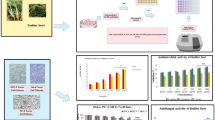Abstract
Two essential oils derived from Lavandula angustifolia and Lavandula × intermedia were investigated for any antiparasitic activity against the human protozoal pathogens Giardia duodenalis and Trichomonas vaginalis and the fish pathogen Hexamita inflata: all of which have significant infection and economic impacts. The study has demonstrated that low (≤1%) concentrations of L. angustifolia and L. × intermedia oil can completely eliminate T. vaginalis, G. duodenalis and H. inflata in vitro. At 0.1% concentration, L. angustifolia oil was found to be slightly more effective than L × intermedia oil against G. duodenalis and H. inflata. The potential applications are discussed.



Similar content being viewed by others
References
Aquarium Pharmaceuticals. http://aquariumpharm.com/en_gb/productCategory.asp?categoryname=Medications. Last accessed 27/4/06
Ariana A, Ebadi R, Tahmasebi G (2002) Laboratory evaluation of some plant essences to control Varroa destructor (Acari: Varroidae). Exp Appl Acarol 27(4):319–327
Athanassopoulo F, Karagouni E, Dostika E, Ragias V, Tavla J, Christofilloyanis P (2004a) Efficacy and toxicity of orally administered anticoccidial drugs for innovative treatments of Polysporoplasma sparis (Sitja-Bobadilla and Alvarez-Pellitero, 1885) infection in Sparus aurata L. J Appl Ichthyol 20:345–354
Athanassopoulo F, Karagouni E, Dostika E, Ragias V, Tavla J, Christofilloyanis P, Vatsos I (2004b) Efficacy and toxicity of orally administered anticoccidial drugs for innovative treatments of Myxobolus sp. infection in Puntazzo puntazzo. Dis Aquat Org 62:217–226
Beach MJ, Roberts JM (2000) Giardiasis surveillance—United States 1992–1997. MMWR CDC Surveill Summ 49:1–13
Benoit-Vical F (2005) Ethnomedicine in malaria treatment. Idrugs 8(1):45–52
Biagini G, Rutter A, Finlay B, Lloyd D (1998) Lipids and lipid metabolism in the microaerobic free-living diplomonad Hexamita species. Eur J Protistol 34(2):148–152
Cavanagh HMA, Wilkinson JM (2002) Biological activity of lavender essential oil. Phytother Res 16:301–308
Clark CG, Diamond LS (2002) Methods for cultivation of luminal parasitic protists of clinical importance. Clin Microbiol Rev 15:329–341
Cudmore SL, Delgaty KL, Hayward-McClelland SF, Petrin DP, Garber GE (2004) Treatment of infections caused by metronidazole-resistant Trichomonas vaginalis. Clin Microbiol Rev 17:783–793
Dunne RL, Dunn LA, Upcroft P, O’Donoghue PJ, Upcroft JA (2003) Drug resistance in the sexually transmitted protozoan Trichomonas vaginalis. Cell Res 13(4):239–249
Force M, Sparks WS, Ronzio RA (2000) Inhibition of enteric parasites by emulsified oil of oregano in vivo. Phytother Res 14:213–214
Hori M (1998) Repellency of rosemary oil against Myzus persicae in a laboratory and in a screenhouse. J Chem Ecol 24:1425–1432
Ignatowicz S (1997) Powdered herbs of the mint family (Laminaceae) as insect repellants for protection of stored wheat grain. Pol Pis Entomol 66:135–150
Karagouni E, Athanassopoulo F, Lytra A, Komis C, Dotsika E (2005) Antiparasitic and immunomodulatory effect of innovative treatments against Myxobolus sp. infection in Diplodus puntazzo. Vet Parasitol 134:215–228
Ketzis JK, Taylor A, Bowman DD, Brown DL, Warnick LD, Erb HN (2002) Chenopodium ambrosioides and its essential oil as treatments for Haemonchus contortus and mixed adult-nematode infections in goats. Small Rumin Res 44(3):193–200
Leung E (2000) Freshwater aquaristik in focus (online). http://www.e-aquaia.com/hexamita.html
Lopes NP, Kato MJ, Andrade EHdeA, Maia JGS, Yoshida M, Planchart AR, Katzin AM (1999) Antimalarial use of volatile oil from leaves of Virola surinamensis (Rol.) Warb. by Waiapi Amazon Indians. J Ethnopharmacol 67:313–319
Moon T, Wilkinson JM, Cavanagh HMA (2006) Essential oils from Australian grown Lavandula spp.: a comparison of antibacterial activity. Int J Aromath 16(1):9–14
O’Brien DJ (1999) Treatment of psoroptic mange with reference to epidemiology and history. Vet Parasitol 83:177–185
Patel SR, Wiese W, Patel SC, Ohl C, Byrd JC, Estrada CA (2000) Systematic review of diagnostic tests for vaginal trichomoniasis. Infect Dis Obstet Gynecol 8:248–257
Perrucci S, Macchioni G, Cioni PC, Flamini G, Morelli I, Taccini F (1996) The activity of volatile compounds from Lavandula angustifolia against Psoroptes cuniculi. Phytother Res 10:5–8
Pessoa LM, Morais SM, Bevilaqua CM, Luciano JH (2002) Antihelmintic activity of essential oil of Ocimum gratissimum Linn. and eugenol against Haemonchus contortus. Vet Parasitol 109(1–2):59–63
Petrin D, Delgaty K, Bhatt R, Garber G (1998) Clinical and microbiological aspects of Trichomonas vaginalis. Clin Microbiol Rev 11:300–317
Plarre R, Poschko M, Prozell S, Andrea F, Wohlgemuth R, Phillips JK (1997) Effects of oil of cloves and citronellol, two commercially available repellents, against the webbing clothes moth Tineola bisselliella Hum. (Lepidoptera: Tineidae)Anz Schadl.kd Pflanzenschutz Umweltschutz 70:45–50
Schwebke JR, Burgess D (2004) Trichomoniasis. Clin Microbiol Rev 17:794–803
Upcroft J, Upcroft P (1998) My favorite cell: Giardia. Bioessays 20:256–263
Upcroft J, Upcroft P (2001) Drug targets and mechanisms of resistance in the anaerobic protozoa. Clin Microbiol Rev 14:150–164
Valentin A, Pelissier Y, Benoit F, Marion C, Kone D, Mallie M, Bastide JM, Bessiere JM (1995) Composition and antimalarial activity of volatile components of Lippia multiflora. Phytochemistry 40(5):1442–1493
Vesy CJ, Peterson WL (1999) The management of giardiasis. Aliment Pharmacol Ther 13:843–850
Zenner L, Callait MP, Granier C, Chauve C (2003) In vitro effect of essential oils from Cinnamomum aromaticum, Citrus limon and Allium sativum on two intestinal flagellates of poultry, Tetretrichomonas gallinarum and Histomonas meleagridis. Parasite 10(2):153–157
Acknowledgements
The authors wish to thank Crestwood Lavender (L. angustifolia) and Forever Lavender (L. × intermedia) for the donation of lavender oils used in this study and to Miss Janelle Wright, Queensland Institute of Medical Research, for advice and technical assistance with this project. This study was funded by a Rural Industries Research and Development Corporation (RIRDC) grant.
Author information
Authors and Affiliations
Corresponding author
Rights and permissions
About this article
Cite this article
Moon, T., Wilkinson, J.M. & Cavanagh, H.M.A. Antiparasitic activity of two Lavandula essential oils against Giardia duodenalis, Trichomonas vaginalis and Hexamita inflata . Parasitol Res 99, 722–728 (2006). https://doi.org/10.1007/s00436-006-0234-8
Received:
Accepted:
Published:
Issue Date:
DOI: https://doi.org/10.1007/s00436-006-0234-8




